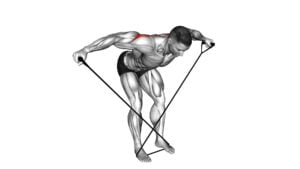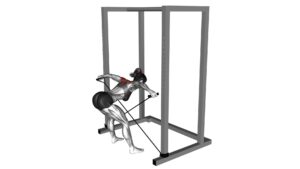Band Bent-Over Rear Lateral Raise (Male) – Video Exercise Guide & Tips

Looking to target your rear delts and upper back? Check out the Band Bent-Over Rear Lateral Raise exercise!
Watch This Exercise Video
In this video guide, we'll show you the proper form and technique to maximize results. Learn how to choose the right resistance bands for your fitness level and avoid common mistakes.
Plus, discover modifications and variations to challenge yourself and tips for incorporating this exercise into your workout routine.
Get ready to strengthen and sculpt those muscles!
Key Takeaways
- Targets and strengthens rear deltoids
- Helps prevent shoulder injuries
- Improves posture
- Stabilizes shoulders
Benefits of the Band Bent-Over Rear Lateral Raise
The Band Bent-Over Rear Lateral Raise provides an effective way to target and strengthen your rear deltoids. This exercise is beneficial for preventing shoulder injuries and improving posture. By specifically targeting the rear deltoids, you can strengthen the muscles that help stabilize your shoulders and reduce the risk of injury. Strengthening these muscles can also improve your overall posture, as they play a key role in maintaining proper alignment of the shoulders.
The Band Bent-Over Rear Lateral Raise is performed by standing with your feet shoulder-width apart and a resistance band securely anchored in front of you. Holding the band with both hands, bend forward at the hips while keeping your back straight. With a slight bend in your elbows, raise your arms out to the sides until they're parallel to the ground. Slowly lower your arms back down and repeat for the desired number of repetitions.
Incorporating this exercise into your workout routine can help you develop strong rear deltoids, which can contribute to improved shoulder stability and better posture. Remember to start with a lighter resistance band and gradually increase the intensity as your strength improves.
Proper Form and Technique for the Exercise
To perform the Band Bent-Over Rear Lateral Raise with proper form and technique, it's important to focus on shoulder alignment and stability. Keep your shoulders down and back, engaging your core for stability throughout the movement.
Additionally, pay attention to your elbow positioning and control, ensuring that your elbows are slightly bent and your forearms are parallel to the ground.
Shoulder Alignment and Stability
Maintain proper shoulder alignment and stability by engaging your core and keeping your shoulders relaxed throughout the band bent-over rear lateral raise exercise. Shoulder stability is crucial for executing this exercise correctly.
Start by standing with your feet shoulder-width apart and a slight bend in your knees. Hinge forward at your hips, keeping your back straight and parallel to the floor.
As you raise your arms to the sides, focus on squeezing your shoulder blades together to activate the muscles in your upper back. Avoid shrugging your shoulders or tensing your neck.
By maintaining correct posture and engaging your core, you'll ensure optimal shoulder alignment and stability throughout the exercise.
Now let's move on to the next section about elbow positioning and control.
Elbow Positioning and Control
To maintain proper form and technique for the band bent-over rear lateral raise exercise, position your elbows in line with your shoulders and maintain control throughout the movement.
Elbow control is crucial in this exercise to ensure that you're effectively targeting your shoulder muscles while avoiding unnecessary strain or injury. By keeping your elbows in line with your shoulders, you're able to engage your shoulder muscles more effectively and promote optimal shoulder strength development.
Throughout the movement, make sure to maintain control and avoid jerking or swinging your elbows. This will allow you to have better focus on the targeted muscles and prevent any potential strain on your joints.
Benefits of Proper Technique
You can maximize the benefits of the band bent-over rear lateral raise exercise by focusing on proper form and technique. One of the key benefits of using proper technique is the increased muscle activation.
When performed correctly, the band resistance targets the muscles in your shoulders and upper back, helping to strengthen and tone these areas. By maintaining a slight bend in your knees and a neutral spine, you can ensure that the tension stays on the targeted muscles and reduces the risk of injury.
It's important to keep your core engaged and your shoulders relaxed throughout the exercise. By following these guidelines and performing the exercise with proper form, you can optimize the muscle activation and reap the benefits of the band bent-over rear lateral raise.
Choosing the Right Resistance Bands for Your Fitness Level
To ensure optimal results, regularly assess your fitness level and select the appropriate resistance bands for your workouts. Resistance band selection plays a crucial role in the effectiveness of your resistance band exercises. The right resistance bands should provide enough resistance to challenge your muscles while still allowing you to maintain proper form and control throughout the movement.
When choosing resistance bands, consider your current fitness level and goals. Beginners may start with lighter bands that offer less resistance, while more advanced individuals might opt for heavier bands that provide greater tension. It's important to find a balance where the resistance is challenging but doesn't compromise your technique.
Additionally, take into account the specific exercises you plan to perform. Different exercises may require different levels of resistance. For example, a bicep curl may require a lighter band compared to a squat or deadlift. Having a variety of bands with different resistance levels can give you more options and allow you to progress as your strength improves.
Now that you understand the importance of choosing the right resistance bands, let's move on to discussing common mistakes to avoid during the band bent-over rear lateral raise.
Common Mistakes to Avoid During the Band Bent-Over Rear Lateral Raise
One common mistake to avoid during the band bent-over rear lateral raise is improper posture. Maintaining the correct posture is crucial to avoiding injury and maximizing results. Here are some common mistakes to avoid:
- Rounding your back: Keep your back straight throughout the exercise to avoid straining your lower back.
- Hunching your shoulders: Avoid shrugging your shoulders or allowing them to creep up towards your ears. Keep them relaxed and down.
- *Tip: Imagine pulling your shoulder blades towards each other as you lift the bands.*
- Using momentum: Don't swing your body or use momentum to lift the bands. This reduces the effectiveness of the exercise and increases the risk of injury.
- *Tip: Focus on slow and controlled movements, engaging the targeted muscles.*
By avoiding these mistakes, you can ensure proper form and technique, which will help you prevent injuries and achieve better results.
Now, let's move on to the next section, where we'll discuss modifications and variations to add challenge or target specific muscles.
Modifications and Variations to Add Challenge or Target Specific Muscles
To add challenge or target specific muscles during the band bent-over rear lateral raise, consider incorporating modifications and variations. These can help you maximize your workout and achieve your fitness goals more effectively.
One modification you can try is using a heavier resistance band. This will increase the difficulty of the exercise and provide a greater challenge for your muscles.
You can also experiment with different hand positions, such as using an overhand grip or an underhand grip, to target different muscles in your shoulders and upper back.
Another variation to consider is performing the exercise on an incline bench. This will change the angle of the movement and place more emphasis on your rear deltoids. Alternatively, you can try a seated version of the exercise, which can be beneficial for individuals with lower back issues.
If you want to specifically target your traps, you can incorporate shrugs into the movement. After completing the rear lateral raise, simply lift your shoulders up towards your ears and hold for a few seconds before lowering them back down.
Remember to always perform these modifications and variations with proper form and technique to avoid injury. Start with lighter resistance or weights and gradually increase as you become more comfortable and stronger. By incorporating these modifications, you can challenge your muscles in new ways and achieve greater results.
Tips for Incorporating the Band Bent-Over Rear Lateral Raise Into Your Workout Routine
To incorporate the band bent-over rear lateral raise into your workout routine, focus on maintaining proper form and gradually increasing the resistance or weights to challenge your muscles. This exercise is effective for targeting the rear deltoids and can be enhanced by incorporating resistance bands.
Here are some tips to help you incorporate this exercise into your routine:
- Start with a light resistance band and gradually increase the tension as your muscles become stronger.
- Stand with your feet shoulder-width apart and slightly bend your knees for stability.
- Hold the resistance band with an overhand grip, hands shoulder-width apart.
- Bend forward at the hips, keeping your back straight and core engaged.
- Keep your elbows slightly bent and lift your arms out to the sides, leading with your elbows until they reach shoulder height.
- Squeeze your shoulder blades together at the top of the movement and hold for a second before slowly lowering the band back to the starting position.
- Aim for 2-3 sets of 10-15 repetitions, focusing on controlled movements and maintaining tension in the band throughout the exercise.
- Remember to breathe properly and listen to your body. If you experience any pain or discomfort, adjust the resistance or consult a fitness professional for guidance.
Frequently Asked Questions
How Many Repetitions and Sets Should I Do for the Band Bent-Over Rear Lateral Raise?
For the band bent-over rear lateral raise, the ideal rep range is typically 8-12 repetitions per set.
This exercise targets the muscles in your shoulders and upper back.
To perform it correctly, stand with your feet shoulder-width apart, hinge forward at the hips, and keep your back straight.
Hold the band with your arms extended in front of you, then lift your arms out to the sides, squeezing your shoulder blades together.
Remember to maintain proper form and technique throughout each set.
Can Women Also Perform the Band Bent-Over Rear Lateral Raise Exercise?
Yes, women can definitely perform the band bent-over rear lateral raise exercise.
Band training offers several benefits for women's upper body strength, including improved muscle tone and increased strength.
To target different muscle groups, women can modify the exercise by adjusting the band tension or changing the hand position.
This allows for a more personalized and effective workout.
Incorporating band training into your routine can be a great way to enhance your upper body strength and overall fitness.
Is It Necessary to Warm up Before Doing the Band Bent-Over Rear Lateral Raise?
Before performing the band bent-over rear lateral raise, it's essential to warm up your muscles. Incorporating warm-up exercises can help increase blood flow, flexibility, and prevent injuries.
Some benefits of warming up include improved range of motion and better muscle activation during the exercise.
Additionally, there are different variations of the band bent-over rear lateral raise that you can try to target specific muscles and add variety to your workout routine.
Can I Use Dumbbells Instead of Resistance Bands for This Exercise?
Yes, you can use dumbbells instead of resistance bands for the band bent-over rear lateral raise exercise. However, using resistance bands has its benefits.
Resistance bands provide constant tension throughout the movement, targeting your muscles effectively. They also allow for a wider range of motion and are portable, making them great for home workouts or when you're on the go.
How Long Does It Take to See Results From Doing the Band Bent-Over Rear Lateral Raise Regularly?
To see results from regularly doing the band bent-over rear lateral raise, the optimal frequency is to perform this exercise 2-3 times a week. Consistency is key!
Avoid common mistakes like using momentum or swinging your arms. Focus on maintaining proper form and engaging your muscles throughout the movement.
With dedication and proper technique, you can start seeing improvements in your shoulder and upper back strength in a few weeks.
Keep up the good work!
Conclusion
In conclusion, the band bent-over rear lateral raise is an effective exercise that targets the muscles of the upper back and shoulders. By using resistance bands, you can easily adjust the intensity of the exercise to suit your fitness level.
Remember to maintain proper form and avoid common mistakes to maximize the benefits of this exercise. Add variations and modifications to challenge yourself and target specific muscles.
Incorporate the band bent-over rear lateral raise into your workout routine for improved upper body strength and posture.

Author
Years ago, the spark of my life’s passion ignited in my mind the moment I stepped into the local gym for the first time. The inaugural bead of perspiration, the initial endeavor, the very first surge of endorphins, and a sense of pride that washed over me post-workout marked the beginning of my deep-seated interest in strength sports, fitness, and sports nutrition. This very curiosity blossomed rapidly into a profound fascination, propelling me to earn a Master’s degree in Physical Education from the Academy of Physical Education in Krakow, followed by a Sports Manager diploma from the Jagiellonian University. My journey of growth led me to gain more specialized qualifications, such as being a certified personal trainer with a focus on sports dietetics, a lifeguard, and an instructor for wellness and corrective gymnastics. Theoretical knowledge paired seamlessly with practical experience, reinforcing my belief that the transformation of individuals under my guidance was also a reflection of my personal growth. This belief holds true even today. Each day, I strive to push the boundaries and explore new realms. These realms gently elevate me to greater heights. The unique combination of passion for my field and the continuous quest for growth fuels my drive to break new ground.







